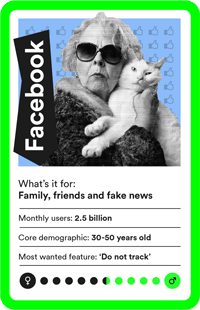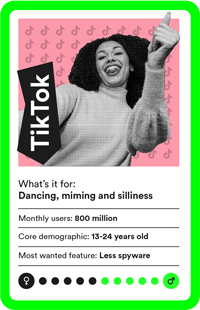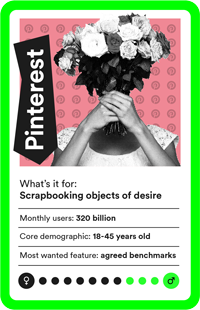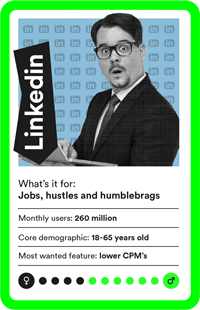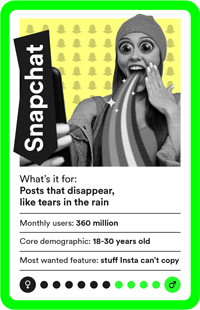Raise your game
Making sense of paid social
Keeping track of the ever-growing pantheon of social media platforms is getting harder: who’s up, who’s down, in and out. And getting it wrong will see you wasting money chasing customers who don’t exist. So, we turned to good old-fashioned Top Trumps technology to help you raise your social media game.
Click a card, any card to jump straight to that entry, or just read on.
The big guns – Facebook and YouTube
Facebook and YouTube rule the world. Hold these two cards in your hand and you’ve basically won. So, what can we tell you about brand-building on these platforms that you don’t already know?
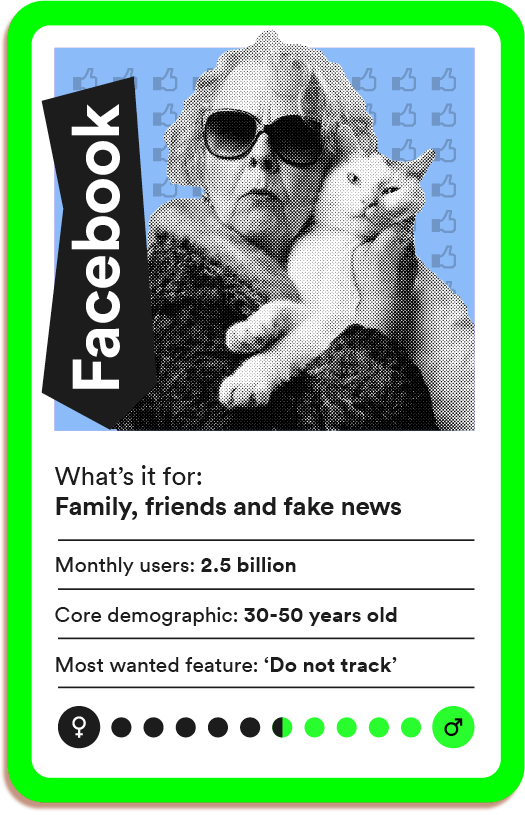
The state of play:
Some say Facebook is so big that it’s the only social network you can see from space. All we know is that Facebook, Instagram, WhatsApp and Messenger now reach over 4bn people a month. And we go where the audience is. So, despite the current boycotts and ongoing content issues, it remains the first port of call for most social advertisers.
When to advertise:
- Targeted mass market and full-funnel social
You really can build an entire sales journey on one platform. The Facebook has the richest set of targeting, retargeting and custom audience building tools of any platform except Google and it’s completely integrated with Instagram, Messenger and soon WhatsApp.
Only Google reaches as many people as Facebook. - When your audience is hard to target conventionally
Facebook has a magic AI that that acts like a huge ever-growing brain that rules from the centre of the ultraworld and finds you lookalike audiences of people similar to your existing customers. Clever stuff. That does entail you putting a lot of trust in Facebook. Historically, that’s a risky move. But, since Facebook has removed most of the niche, hand-targeting options that we used to enjoy, we really don’t have much choice. So, watch your ROI like a hawk and switch tactics if conversion costs start rising. - ‘Facebook is for olds’
…as the youngsters say. Realistically, it’s the only social channel where you can reach the over 50s at scale.
As an aside, it’s worth noting that Facebook does reach a lot of 18-30yr-olds, it’s just that other platforms let you reach more of them.
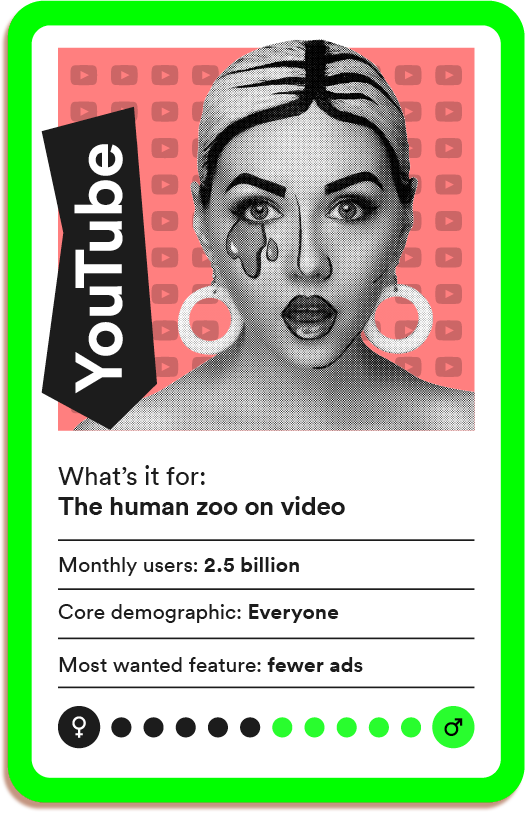
YouTube
The state of play:
As a comms agency, we hate to admit that there’s such a thing as too many ads, but we did recently watch an 11-minute video with four separate ad breaks. And nearly went mad in consequence. Target with care to avoid being lost in all the noise.
YouTube is also the natural home of product explainers and demonstrations especially if you have a complicated product or one with lots of possible uses.
When to advertise:
- Full funnel integrated campaigns
Don’t think of YouTube as a social video channel, think of it as the top of your sales funnel. Grab your brand some attention in YouTube then chase people around the internet with retargeted follow-up display ads, search ads and shopping listings as they move through the sales journey. - Influencers
Long before Instagram was even a thing, YouTube had a gaggle of creators willing to promote your product to their audiences. Whatever your business niche, there will be content worth sponsoring and creators worth collaborating with. - Targeted mass marketing
All the clever things we can use to target search ads: keywords, history, behaviour and interests can be applied to YouTube too. - Niche interest targeting
Facebook has removed thousands of niche interests and targeting opportunities over the last few years, so you must target broadly and trust its AI. YouTube and Google ads give you much greater control. You can even target viewers of individual YouTube videos if you want.
The Battle Royale – Instagram vs. TikTok
Grab a big bucket of popcorn, pull up a comfy chair and settle in to watch, because this is going to be an epic battle. This fight has everything, from cat videos to geopolitics. They’ll probably make a Netflix series about it one day.

TikTok
The state of play:
New kid on the block, TikTok, has doubled its userbase in 2020, topping download charts across the world as people rushed to get their hands on it. Fast, fun video of people doing silly things, often in time to music, turns out to be what the Internet is really for.
But there are problems. That very success brings it into direct competition with the Facebook empire! (cue Star Wars imperial march)
You may remember Snapchat. It learned the hard way just how harsh the social media playground can be when the big boys start throwing their weight around. Instagram copied its homework, nicked its lunch money and left it crying in the corner. Instagram’s Reels feature, that duplicates many TikTok features, is just the start of its fightback.
Apart from that, TikTok is also politically vulnerable. It sends a lot of personal data off to China, so Bytedance (TikTok’s Chinese owner) is prey to many of the same trust issues that plague Huawei. And the criticisms are largely fair: data collection is aggressive and surreptitious, leading to it being removed from app stores in India and put under 90 day’s notice to sell US operations to a US company or face a ban in the States.
Finally, this is still not a mature platform. Yes, it does offer self-serve advertising tools, but they have only been in place since January, so lack sophistication. There also isn’t an API which means there is no way to manage your TikTok channel using tools like Hootsuite.
When to advertise
- When your product is young, fast and fun
Fast, fun, consumer products appealing to 13-24 year-olds are perfect for TikTok. 25-35 year-olds are increasingly joining the platform, with a focus on young mums. - For brand awareness
It’s a perfect brand channel. It’s inherently emotional and distinctiveness is rewarded.
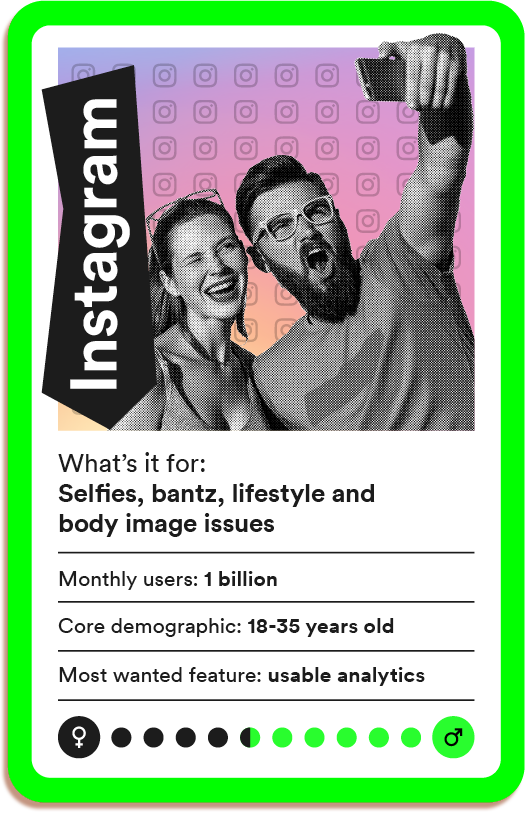
The state of play:
Instagram’s first move to counter TikTok’s success is to upgrade stories (the feature Instagram copied from Snapchat) and call it ‘Reels’. It will become a lot more focal, eclipsing the news-feed, making Instagram even more video-based.
Along the way, it would be nice if good organic analytics could be made available outside the app. And if they were made useable at the same time, that would just fab.
When to advertise:
- Influencers
Instagram is the spiritual home of the influencer. From self-serve platforms like Tribe to social media megastars, you can always find someone willing to work with your brand. Use tools like these to weed out the people who have 8 real followers and 283,932 fake ones. - Full-funnel campaigns
All that insane Facebook AI audience finding goodness is also available for Instagram. You can build cross-platform campaigns and integrated retargeting journeys across the whole Facebook estate, it’s scarily easy to spend your entire media budget in one place. - Augmented reality
All those pictures of teenagers with bunny ears, devil horns, laser eyes and other assorted augmented reality (AR) madness? Branded Instagram AR lenses are very cool, pretty straightforward to build and popular with youngsters. This is not really a ‘when to advertise’ as such, as you can’t sponsor your AR filter directly. You can, however, collaborate with influencers to get people try your filter and spend time having fun in your brand space.
The middleweights – Twitter, Pinterest and LinkedIn
The middle-ranking social networks each have their strengths and weaknesses from a brand-building viewpoint. So, when should you use them?
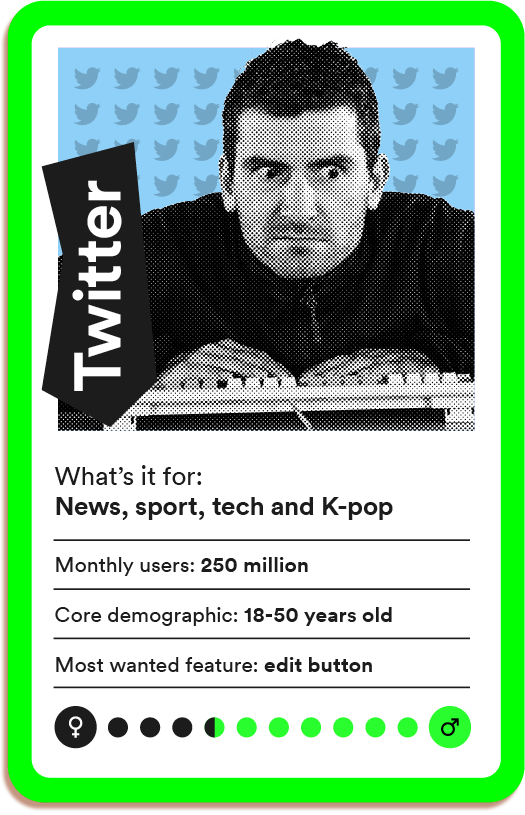
The state of play:
In terms of fame, Twitter really punches above its weight. In terms of monthly users, it’s no larger than Snapchat, which many now consider irrelevant. This is mainly because of its importance as an instant reaction channel for news and sport, and of course Donald Trump. It’s fascinating to see the transition between news Twitter during the week and sports Twitter at the weekend. All the trends change overnight.
When to advertise:
- News or Sport-related products
This is the core demographic of Twitter fans. For sport-related products, we can interpret this fairly widely. A good example might be advertising wide-screen TV’s on Twitter in the run-up to the Olympics. Think laterally. - Niche interests
Because of its very open and public structure built around topics rather than people, Twitter has lots of very strong interest-based niches. K-pop is huge on Twitter. Tech-folk flock there. If your brand appeals to one of these niches, this is the place for you.

The state of play:
This is the social platform on which where users are most likely to welcome brand activity, because many of its users are actively planning purchases. The clichéd use of Pinterest is planning a wedding or a kitchen refit. Fashion, the arts, lifestyle and similar topics are all strongly represented.
Pinterest is also very brand safe. A haven of positivity in a contentious world. We’ve yet to see any hate speech since starting to use it in earnest and adult content is largely banned. Pinterest has also managed to steer clear of a lot of the controversy that surrounds other networks.
On the downside, it’s difficult to be sure how to measure and value engagement. The analytics tools are good, but there’s no real agreed sense of what constitutes ‘good’.
When to advertise:
- All of the time
We like Pinterest as a channel for advertising. The ads don’t feel obtrusive amongst the content, but also don’t disappear. It’s very visual and emotional, so a great brand channel. And it’s brand safe. - When you want to sell stuff
More than almost any other channel, people on Pinterest are in the market to buy. If not now, then soon. - When not to advertise
When your audience is predominantly male.
When your product isn’t very visual or takes a lot of explaining – this wouldn’t be a great place to advertise complex financial products, for example.

The state of play:
LinkedIn is the network everyone loves to hate. Full of humblebraggers, tone police and exhortations to work 28 hours a day, it’s somehow still so useful that we’re all on there. But then, it has no real competitors. It’s got the space to itself. If it had competition, ad costs would be lower and the user experience wouldn’t be so dreadful.
On the advertising side, its full-funnel marketing tools for retargeting and lookalike audiences are primitive. LinkedIn’s saving grace for advertisers is that the conventional targeting tools are so good this hardly matters.
When to advertise:
- B2B
If you need to target people by industry, job-role or responsibility, nothing else comes close. - Job adverts
Whatever else changes about LinkedIn, it will always be where we go for job ads. - For hyper-targeting
Need to target HR managers in companies with 250-1000 employees in a 50-mile radius of Doncaster? No problem. As long as there are more than a few hundred people who fall into that designation, you can target only them. At that point, costs per thousand impressions (CPM’s) skyrocket because you are bidding for very scarce impressions. We’ve seen CPM’s as high as £80, which is eye-watering. But if you absolutely, positively have to reach just the right decision-makers, accept no substitute. - When you are feeling affluent
LinkedIn CPM’s are about 2-3x as high as on other platforms. Even for mass marketing. - When you are targeting the affluent
Since you can no longer target by income on any major platform, at least in the UK, what people do professionally is a pretty good proxy measure. CEO’s of companies with 250+ employees are unlikely to be poor, for example. Audi used LinkedIn to launch its Q7 luxury SUV for precisely this reason.
The wildcards – networks for niches
These platforms may be outside the mainstream, but they can be surprisingly useful.

Snapchat
The state of play:
Originally popular with teenagers for posts that disappear after viewing, its initial popularity was driven by its ‘Parent-proof’ nature. After a dodgy start it grew-up fast, becoming more respectable and transforming into a place for teenagers generally, with cool AR filters, stories and weird sunglasses.
Then in 2016, Instagram decided to ‘be inspired by’ all of Snapchat’s cool features including stories and AR. Since then, it’s been ‘so, like, last decade, darling’. In fact, we hadn’t opened Snapchat in over a year before writing this piece. But it still has more monthly users than Twitter, Pinterest or LinkedIn. Not bad for a ‘failed’ platform.
When to advertise
- If Facebook and TikTok boycotts become critical
Right now, it’s hard to think of a compelling commercial reason to advertise on Snapchat over Instagram. It’s more expensive and reaches fewer people. But, one solid reason to head for Snapchat would be to target young audiences if you don’t want to advertise on TikTok or Instagram.
Ironically, given its roots, it might be one of the more ethical places to advertise right now. Strange days indeed. - When you want to reach teens and young adults
It’s still Snapchat’s core demographic.
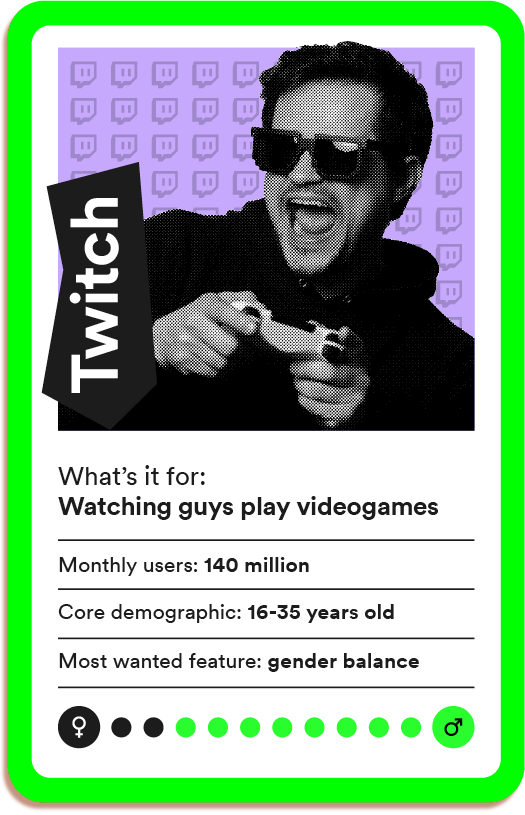
Twitch
The state of play:
Watching other people play videogames is one of those things that seems incomprehensible to many, but it’s huge: try to think of Twitch as YouTube for gamers. And, of course, lockdown has sent the userbase skyrocketing.
The games industry dwarfs Hollywood, and with that rise have come superstar eSports players who earn millions in tournament and sponsorship fees each year. Those eSports players are, of course, influencers in their own right.
This is a very male-dominated space. So, it’s an effective place to advertise the kind of things that appeal to young men at the geekier end of the spectrum. At risk of sounding cliched, that means all the things we associate with young men: technology, games, sport, fashion and fast food.
On the downside, being in an environment so heavily dominated by young men comes with issues: female players often feel they can’t reveal that they are women because it can become a quickly become a hostile space. Since we’re aware of several female gamers who pass as male on Twitch, this is plainly an issue.
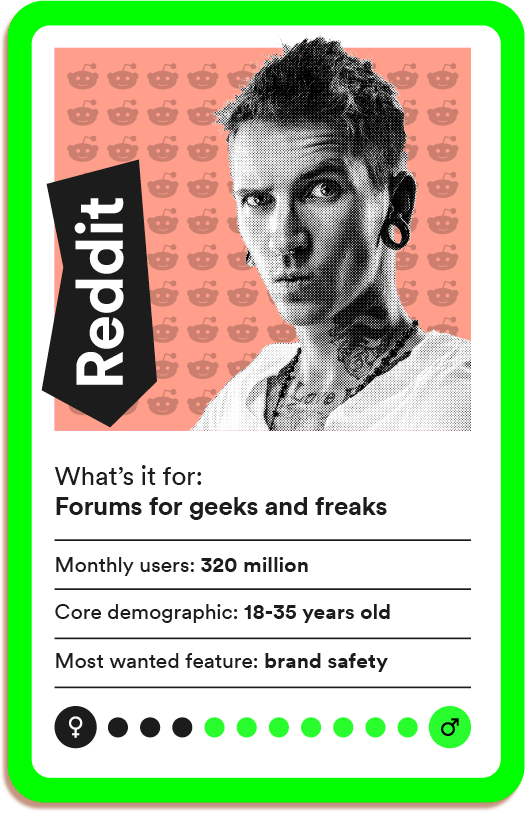
The state of play:
Sometimes called ‘the front page of the Internet’, Reddit is part discussion forum, part meme hive, part content stash. Kind of like a long-form Twitter.
Like Twitch it’s heavily dominated by young men. And for that reason, it can harbour some very strange content indeed – despite thousands of moderators (known as subredditors). Not only that, but Reddit remains the spiritual home of the ‘silence, brand’ meme. Its users are sophisticated media consumers, unafraid of calling out brand BS.
This means brand safety issues just won’t go away, driving out advertising dollars. And because of that, it’s mostly tech. brands advertising on Reddit. So, why would you be prepared to take the risk? Well, its core audience contains one of the most affluent under 30s demographics going: smart, geeky with lots of disposable income. But it’s still a risky play.
Playing the game
At first glance, all these platforms seem to make life more, rather than less, complicated. But we can take a measured view. There’s no need to be omnipresent. As always, it’s about finding the right audience so we can reach them effectively.
One thing that’s great about looking at one of these platforms and thinking ‘I wonder…’ is that validating your hunch should be easy and cheap.
- Creative for one channel can normally be repurposed easily and cheaply for different channels.
- Low-volume paid media tests, try-outs and forays into each platform can give you a lot of information for a low spend.
Because of this, the cost of being wrong is small, while the gains from being right are big. This makes it a good idea to test out new platforms alongside other activity. And that has always been a good plan in advertising. ‘Never stop testing, and your advertising will never stop improving,’ as David Ogilvy put it.
To see some of our work, click here for case studies on how we’ve helped BUPA, Pets at home, Silentnight, Marriott, Brother, Wagamama and many more.
Alternatively, if you’d like to learn more, give us a call on 0161 831 0831 and ask for Nicola or get in touch at hello@dinosaur.co.uk.
Also published on Medium.







